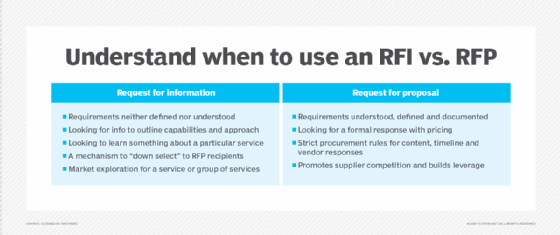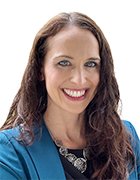
Getty Images/iStockphoto
How to write a winning RFP response
Sales teams face constant pressure to write winning RFP responses. Best practices, such as personalizing responses, can help them stand out from competitors.
As organizations compete for the same customers, they rely on sales teams to craft clear and compelling RFP responses.
Sales teams face obstacles like tight deadlines, unclear customer expectations and resource constraints as they respond to requests for proposal. They must also interpret ambiguous requirements, tailor responses to the customer and maintain consistency across multiple submissions. To overcome these challenges, sales teams require a structured and strategic approach that emphasizes clarity, precision and alignment with customer needs.
RFP response best practices include the following:
- Personalize responses.
- Use simple and clear language.
- Include an executive summary.
- Highlight differentiators.
- Collaborate with subject matter experts (SMEs).
- Automate repetitive tasks.
6 best practices for an RFP response
RFP responses should be customer-centric, use clear language and include an executive summary to capture the attention of evaluators.
1. Personalize responses
An effective RFP response prioritizes the customer's unique requirements and pain points. Sales teams should analyze the RFP to identify the customer's goals and tailor responses to address them directly. This personalization shows understanding and alignment with customer expectations.
For example, if a retailer issues an RFP for a new CRM system, the sales team can highlight features that address the retailer's specific challenges rather than offering a predefined, generic list of capabilities. It might also include a customized workflow diagram showing how the CRM platform integrates with the retailer's existing e-commerce platform.
To learn about a prospective customer's strategic priorities, sales teams can conduct targeted research, such as reviewing the client's recent press releases, annual reports or public statements. They might also interview stakeholders who work for the customer, such as procurement leads or department managers, to clarify operational pain points, requirements and success criteria.
Example excerpt
Generic response
Our cloud-based CRM system offers industry-leading features, including contact management, sales pipeline tracking and reporting capabilities that can benefit any organization that wants to improve customer relationships.
Personalized response
As a multilocation retailer experiencing 30% annual e-commerce growth, your team needs visibility across physical and digital customer touchpoints. Our CRM system unifies your in-store point-of-sale data with online shopping behaviors to give your sales reps a complete view of each customer's journey. This directly supports your stated goal of increasing repeat purchases by 15% this fiscal year.
2. Use simple and clear language
RFP response writers should communicate ideas clearly to avoid confusion or misunderstanding. Complex jargon, overly technical language or passive constructions negatively affect readability. Instead, they can use simple language, short sentences and active voice.
The following writing samples contrast ineffective and effective writing:
- Ineffective writing. Our CRM solution's implementation shall be facilitated by robust integration capabilities that are leveraged to synergistically streamline cross-departmental data migration.
- Effective writing. Our CRM platform integrates with your existing systems, making data migration faster and less disruptive for every department.
The second sentence uses clearer, more direct language. Evaluators -- especially nontechnical ones -- can more easily understand this style of writing.
3. Include an executive summary
An executive summary offers a high-level overview of an RFP response in about 400 to 1,000 words. It plays a critical role in client engagement because it's one of the first things evaluators see. An effective summary highlights differentiators, which are features that set an organization's product or service apart from competitors. It also summarizes key points and benefits, such as migration timelines and ROI estimates.
Like the proposal itself, teams should personalize the summary to quickly capture evaluators' attention. For example, it could outline specific outcomes and benefits to address the client's needs rather than generic statements about the organization or product. This approach draws readers in, as it directly ties proposed outcomes to the customer's goals.
Example excerpt
For Northstar Retail Group: Unified Customer Experience Platform
Northstar's challenge: Connecting disjointed customer data across 85 locations and your e-commerce platform while training over 300 associates on a new system without disrupting operations.
Our platform delivers:
- Seamless integration with your existing Oracle ERP system, requiring zero downtime.
- Unified customer profiles accessible across all channels within 45 days of implementation.
- Phased training approach allowing associates to maintain productivity during transition.
- Projected 22% reduction in customer service resolution time based on similar retail implementations.
Unlike competitors proposing six-month deployment timelines, our FastTrack methodology will have your core systems operational within 60 days, aligning perfectly with your holiday season preparation timeline as specified in your RFP requirements.
4. Highlight differentiators
Differentiators highlight specific advantages, such as advanced automation capabilities or exceptional customer service, to make an organization's RFP response stand out against competitors.
For instance, if a logistics software vendor offers similar pricing to competitors but has a 24/7 live support line, while the others only offer email support, the proposal should explicitly emphasize this difference to stand out. The sales team might write: Unlike standard email-only support, we provide 24/7 live phone support to resolve critical issues in real time.
Clearly articulated differentiators can nudge evaluators to select one RFP response over another.

5. Collaborate with subject matter experts
Sales teams should engage SMEs -- individuals with deep knowledge on a particular subject -- to enhance proposal accuracy, depth and credibility. These experts offer authoritative insights and technical precision, which make RFP responses more detailed and convincing.
For example, in an RFP response for an aerospace contract, an SME might draft a section detailing how the proposed avionics system meets specific safety certifications. If SMEs contribute directly, the team avoids inaccuracies or generic descriptions that could weaken technical evaluations. Sales teams should include SMEs early in the response process so they can identify relevant capabilities and potential compliance issues.
6. Automate repetitive tasks
Automation software can help sales teams streamline routine tasks, increase efficiency and reduce errors. It also gives teams more time to focus on higher-level tasks, such as researching a client's pain points. RFP response automation tools can help teams manage reusable content libraries, auto-fill standard forms and track compliance checklists.
For example, a sales team might use an automation tool to insert boilerplate legal disclaimers into responses. This saves time and reduces the risk of outdated content.
5 key elements of an RFP response
An effective RFP response draws evaluators in, offers a detailed summary, and includes an implementation plan and timeline.
1. Cover letter
The cover letter introduces an organization's RFP response in about 250 to 400 words. It immediately establishes rapport and communicates the primary value proposition.
To create an effective cover letter, sales teams should use concise language and personalize it to directly reflect customer needs. They should also highlight key benefits of the tool, express enthusiasm and briefly address the client's challenges.
Example excerpt
We are excited to help [client] improve customer retention by implementing a CRM system tailored to the organization's retail environment. This proposal outlines how our software can help [client] increase loyalty program participation and enhance customer insights.
2. Executive summary
An executive summary is more detailed than a cover letter and offers a comprehensive overview of an entire RFP response. A compelling summary emphasizes a proposed product's or service's core differentiators and main benefits to customers. It should summarize how the product or service addresses the customer's problem, outline anticipated outcomes and explain how it stands out from competitors.
Example excerpt
Our CRM platform's personalized marketing automation features will increase loyalty program sign-ups by 20% within the first year.
3. Case studies and references
Sales teams should include relevant case studies to demonstrate proven success. Effective case studies tell a brief story of how the organization solved a similar challenge in the past and should focus on measurable results to offer clear evidence based on data. These sections can outline a problem, action and outcome.
Example excerpt
Retailer X wanted to reduce cart abandonment. We implemented automated follow-up emails that resulted in a 12% increase in completed purchases within three months.
4. Pricing and deliverables
Clear and detailed pricing, alongside explicit deliverables, can enhance transparency. Sales teams should avoid ambiguous terms, like approximate or subject to change, to build trust. Instead, they can itemize costs and link them directly to deliverables. This shows evaluators how pricing aligns with the proposed product or service.
Example excerpt
- CRM software license: $50,000 per year.
- Data migration service: $10,000 one-time fee.
- Training for 50 users: $5,000.
5. Implementation plan and timeline
A detailed implementation plan reassures evaluators of an organization's preparedness. It should outline key milestones, responsibilities and timing.
Example excerpt
- Weeks 1 to 2: Project kickoff and requirements workshop.
- Weeks 3 to 6: System configuration and integration testing.
- Weeks 7 to 8: User training and pilot rollout.
- Week 9: Full deployment and go-live.
Sales teams can also include contingency plans to further build confidence. For instance, they might specify that, if data migration takes longer than two weeks, the organization will allocate additional resources at no extra cost to maintain the customer's timeline.
Key takeaways
Sales teams can win more proposals if they consistently apply RFP response best practices and incorporate key proposal elements. A strong focus on clarity ensures evaluators quickly understand the value proposition, while customer-centric messaging demonstrates a deep understanding of the client's needs, priorities and pain points.
At the same time, sales teams should articulate their organizations' unique differentiators to set themselves apart from the competition.
Together, these practices empower sales teams to craft persuasive, well-structured responses that align with the client's and organization's goals. This approach enhances organizational credibility, builds stronger client relationships, and contributes to higher win rates and increased market competitiveness.
Robert Peledie is an enterprise architect, solution architect and director of CRM consultancy 365Knowledge Ltd. He has several years of consulting experience in global organizations.








